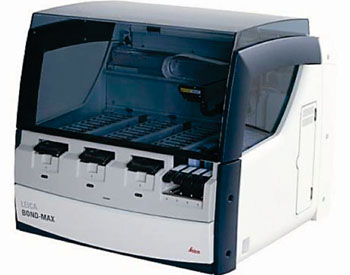Prognostic Index Identifies Risk of Testicular Cancer Relapse
By LabMedica International staff writers
Posted on 03 Nov 2015
The assessment of just three features can identify those at most at risk of relapse of a common kind of testicular cancer known as non-seminomatous germ cell tumor (NSGCT) even where there is no evidence of tumor spread. Posted on 03 Nov 2015
Predicting who does or does not need chemotherapy is important in order to minimize treatment, with its undesirable side effects and a new test could be used in clinics to make decisions about which patients should be given chemotherapy. Patients diagnosed with testicular cancer in the early stages face a choice between monitoring with treatment, if relapse occurs, and moving directly on to chemotherapy with its associated long-term side effects.

Image: The Bond-Max automated immunostainer (Photo courtesy of Leica Biosystems).
Scientists at The Institute of Cancer Research (Sutton, UK) analyzed 177 tumor samples from patients with stage 1 non-seminomatous tumors, enrolled in clinical trials through the Medical Research Council (MRC) Clinical Trials Unit. Specifically these were patients diagnosed with stage I NSGCT (negative tumor markers and computer tomography scan confirming stage I) and enrolled post-operatively into a randomized study of two alternate imaging surveillance protocols.
Complete tumor cases were retrieved from each patient, and a full set of hematoxylin and eosin (H&E) sections from tumor for each case were examined by a board certified histopathologist. Sections were deparaffinized prior to immunochemical staining for C-X-C motif chemokine 12 (CXCL12) (R&D Systems; Minneapolis MN, USA). Antibodies were visualized using the Bond Polymer Refine Kit (Leica Biosystems; Newcastle, UK). Immunostaining was performed on the Leica Bond-Max automated immunostainer. To investigate CXCL12 as a marker for relapse prior to application to the clinical trial sample sets, the team first studied the tissue microarrays (TMA) representing 59 cases.
The tests were validated in an additional group of 80 patients. The vast majority of patients were in the low-risk group: 94.3% did not relapse in two years. In the moderate-risk group, 65.9% did not relapse. Strikingly, only 30% of patients did not relapse in the high-risk group. The authors concluded that CXCL12 and percentage embryonal carcinoma both stratify patients’ relapse risk over and above vascular invasion alone. This is anticipated to improve the stratification of patients and identify high-risk cases to be considered. The study was published on October 3, 2015, in the journal Clinical Cancer Research.
Related Links:
The Institute of Cancer Research
R&D Systems
Leica Biosystems














